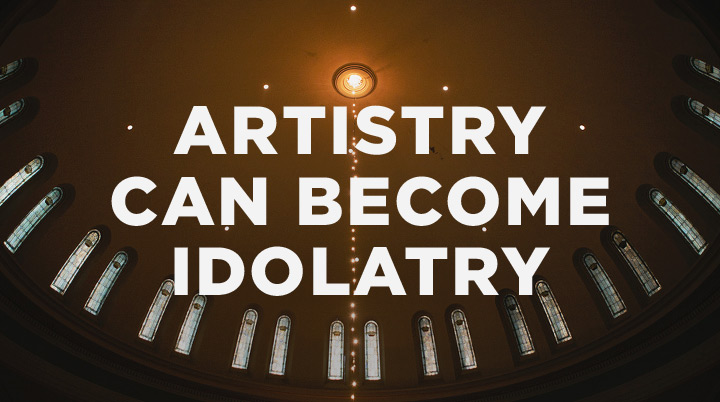Latest
-
Objections to the Christian Faith from the Unchurched and De-Churched
 Tue Dec 02, 2014
Tue Dec 02, 2014
by Resurgence -
Craig Groeschel: We Innovate for Jesus
 Tue Oct 14, 2014
Tue Oct 14, 2014
by Resurgence -
Mark Driscoll: Revelation
 Tue Oct 07, 2014
Tue Oct 07, 2014
by Resurgence -
RESURGENCE LEADERSHIP #034: JOHN PIPER, WHY I TRUST THE SCRIPTURES, PART 2
 Tue Sep 30, 2014
Tue Sep 30, 2014
by Resurgence -
Resurgence Leadership #033: John Piper, Why I Trust the Scriptures, Part 1
 Tue Sep 23, 2014
Tue Sep 23, 2014
by Resurgence

Archives
4 ways artistry can become idolatry

This week, I preached on the second commandment. In the first commandment God tells us who to worship: only him. In the second commandment God tells us how to worship, and to not worship idols.
“You shall not make for yourself a carved image, or any likeness of anything that is in heaven above, or that is in the earth beneath, or that is in the water under the earth. You shall not bow down to them or serve them, for I the Lord your God am a jealous God, visiting the iniquity of the fathers on the children to the third and the fourth generation of those who hate me, but showing steadfast love to thousands of those who love me and keep my commandments.”
–Exodus 20:4–6
An arty, jock, altar boy
I was raised Catholic and served for a few years as an altar boy while attending Catholic grade school. I’ve got an artistic bent. I like architecture, interior design, music, visual arts, etc. Growing up I was an odd mix: a jock who played a lot of sports, a fighter who got in more than a few brawls, and an artist who liked to sketch, draw, and experiment with various mediums. I appreciated the artistry of the Catholic Church. Stained glass, paintings, colors, icons, statues, candles—it was all quite beautiful.
Some Catholics are born-again, Jesus-loving Christians. I was not one of them. I was a spiritual religious guy until Jesus saved me at the age of 19. At that time, I started attending an evangelical Protestant church. The first thing I noticed is that it was very plain in comparison to my Catholic upbringing. No icons. No paintings. No candles.
Pretty soon, I started reading up on the history of the Protestant Reformation. I learned that Protestants were intentionally plain in the building and furnishing of their church worship spaces. They feared that some people had started acting like pagans worshiping created things instead of the Creator God, as if art was a mediatorial conduit between us and God, bringing God near to us. This made sense to me as I had seen people pray to saints, leave gifts at the statues of saints much likes pagans do their own false gods, and let the focus of worship deviate from the Creator to things created.
Smashing idols
This week, I preached on the second commandment. In the first commandment God tells us who to worship: only him. In the second commandment God tells us how to worship, and to not worship idols.
This brings me to the issue I want to address. It has very practical implications for how we set up our churches, what the role of art in worship is, and at Mars Hill even what we do with the old church buildings we are buying and refurbishing to be our church homes. Are there certain things we should smash like the Protestants of old because they promote idolatry under the guise of Christianity?
God loves art
The prohibition against using images to represent God does not indicate that God is an opponent of art in the worship of him. When constructing the temple, God had commanded that colors and shapes from the natural world (fruit, flowers, trees, etc.) be used, but no image of himself (1 Kings 6:16–18). This distinguishes worship of the one true God from paganism, because in paganism physical representations of the gods serve as magical contact points between the gods and people, through which revelation and power are given.
Are there certain things we should smash like the Protestants of old?
Conversely, Israel had a different sort of relationship with God that came through mediation with prophets, priests and kings (foreshadows of Jesus Christ) as the points of contact between God and his people. This mediation was necessary because a sinful person could not come directly to God. Paganism, however, does not recognize the holiness of God and the sinfulness of people and therefore teaches that people can come into direct, unmediated contact with the gods, and even manipulate the gods to grant them their wishes through the control of physical representations of the deity.
At pagan shrines if you feed a god with an offering (food, money, or a sacrifice) then the god will bless you. When this same idolatry ideology is used at a statue of Mary or even Jesus, the image may be biblical but the worship is pagan.
The image of the invisible God
Because of the second commandment the church has often struggled with the question of whether or not it is idolatry to have paintings and images of Jesus. Since he came in the flesh, it does not seem as though we are making an idol if we attempt to show his humanity. But God has made it difficult for us to picture Jesus’ appearance since the only information the Scripture reveals about such things is that he was not particularly beautiful, and that in preparation for his crucifixion he was beaten so badly that he barely resembled a man (Isa. 52:14, 53:2).
Paul says that idolatry is when we worship and serve created things (including art) rather than the Creator
But Jesus has given us the elements of bread and wine for use in our worship as a picture of his body and blood given for the forgiveness of our sins as a form of symbolism which forces us to focus on his sacrifice instead of his appearance.
Throughout the history of the church there has been a debate between those who propose that images should be used in the worship of God (iconodules) and those who believe that images should not be used in the worship of God (iconoclasts). Since even a cursory reading of the Scriptures clearly shows that God favors the arts, creativity, and beauty, it seems that images and the arts are, like the law, profitable when used rightly. For example, the many works of Rembrandt greatly aid in worship and devotion since they show many events from Jesus’ life and ministry.
Because of the second commandment the church has often struggled with the question of whether or not it is idolatry to have paintings and images of Jesus.
But any attempt to show God apart from Jesus seems to qualify as idolatry. Colossians 1:15 tells us that Jesus is “the image of the invisible God.” The Greek word used for image in this passage is eikon, from which we get the English word icon. Therefore, we do not need a picture of the invisible God, who is Spirit (John 4:24), but rather we are to fix our eyes on Jesus.
As a guiding rule, I would suggest that artistry becomes idolatry most commonly in four ways:
1. Artistry becomes idolatry when we claim that it is mediatorial.
Paul is clear that only Jesus mediates between us and God (1 Tim. 2:5). There is no one and nothing else that mediates but Jesus. Those who are prone toward paganism are easily confused on this point. As one example, Swiss philosopher Max Picard wrote, “Here is an independent region, that of art, and we believe that in this way a region has been created between earthly and heavenly things, a region which touches earthly and heavenly things without these touching each other.” Practically, this same error is made when someone says that in a particular building they feel “closer to God,” or when a well-intended but misguided worship leader says that their music will “usher us into the presence of God.”
2. Artistry becomes idolatry when any attempt is made to show God the Father.
The Bible says that God the Father is Spirit, and that God is not a man. Jesus came as a man, and the Holy Spirit appeared like a dove. But the Father cannot be shown in any imagery. Perhaps the worst of all is when God the Father is shown as an old man. G.K. Chesterton once rightly said that we grow old because of sin, and because God never sinned he alone does not grow old and is younger than us all.
3. Artistry becomes idolatry when there is confusion between the Creator and the created.
In the opening chapter of Romans Paul says that idolatry is when we worship and serve created things (including art) rather than the Creator (Rom. 1:18–25). If at any point and in any way this happens, the second commandment has been violated. This is common in worldviews such as pantheism and panentheism where the Creator/created distinction is blurred or obliterated. Wicca, Native American spirituality, and radical environmentalism that worships God as Mother Earth instead of Father God are all examples.
A pet peeve of mine on this point is prayer labyrinths. If you've not seen one of these silly things, you start at the edge of a circle and walk in to the center as an act of worship. The goal is turning in upon oneself until you are at the center. This is the path to sin and not salvation. Luther said that sin is the self bending in on the self. The Christian path to salvation is not the self turning in to the self, but the self turning out to God as an act of repentant faith. The center of our spirituality is the Creator and not ourselves, the created.
4. Artistry becomes idolatry when the gathered worship of God’s people is no longer Word based.
Churches that get rid of sermons so that people can paint or meditate on icons are simply wrong. Ours is a Word-based faith. The world came into being by God’s Word. When priests taught God’s people and prophets rebuked God’s people, they did so by delivering God’s Word. Jesus came as the Word of God, and faith comes by hearing the word of God (Rom. 10:17), not seeing the artist’s rendition of what their personal experience of God is. Worship is not merely singing words to God, but listening to God’s Word.
I am for artistry when it is subservient and obedient to God’s Word. I love old church buildings, stained glass, and great music. I have the great honor of being the pastor to what is largely a young, arty, creative church. And I praise God that they love the Word of God and the God of the Word, using their artistry for ministry and not idolatry.